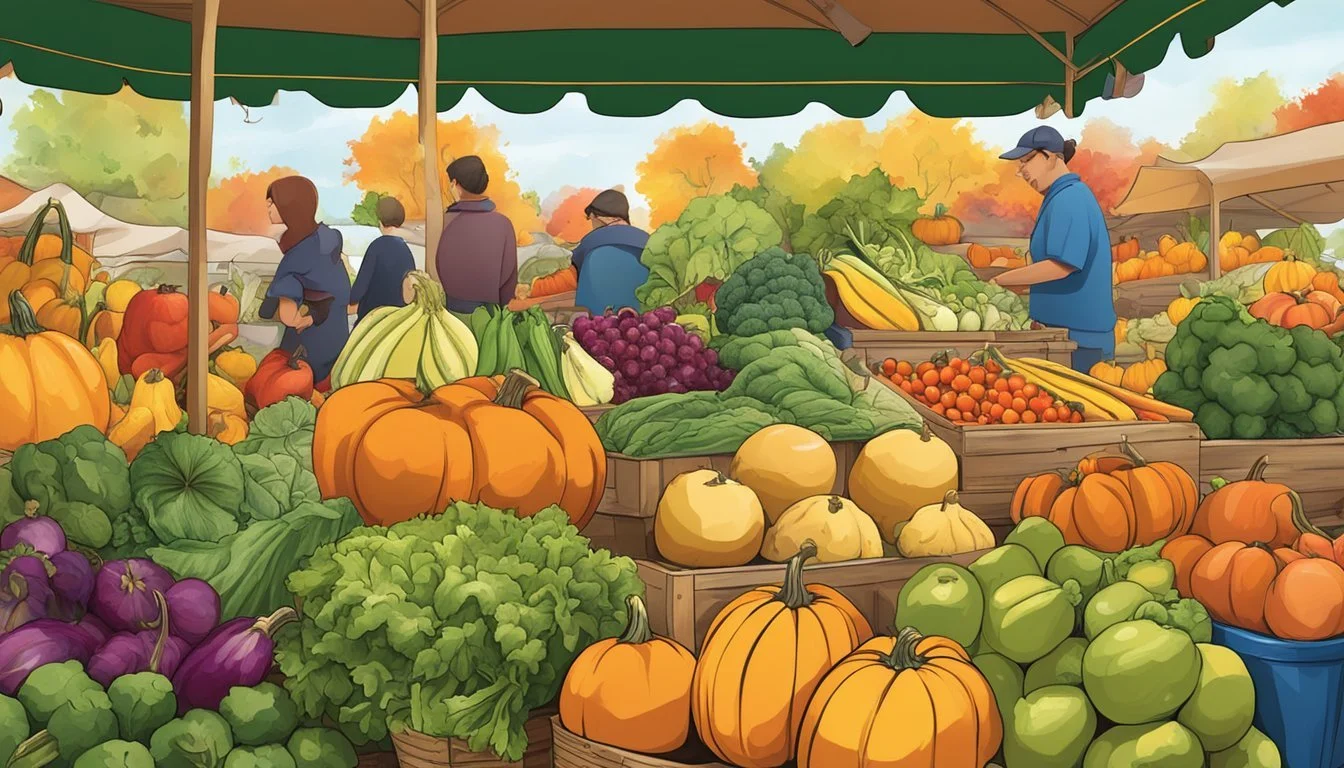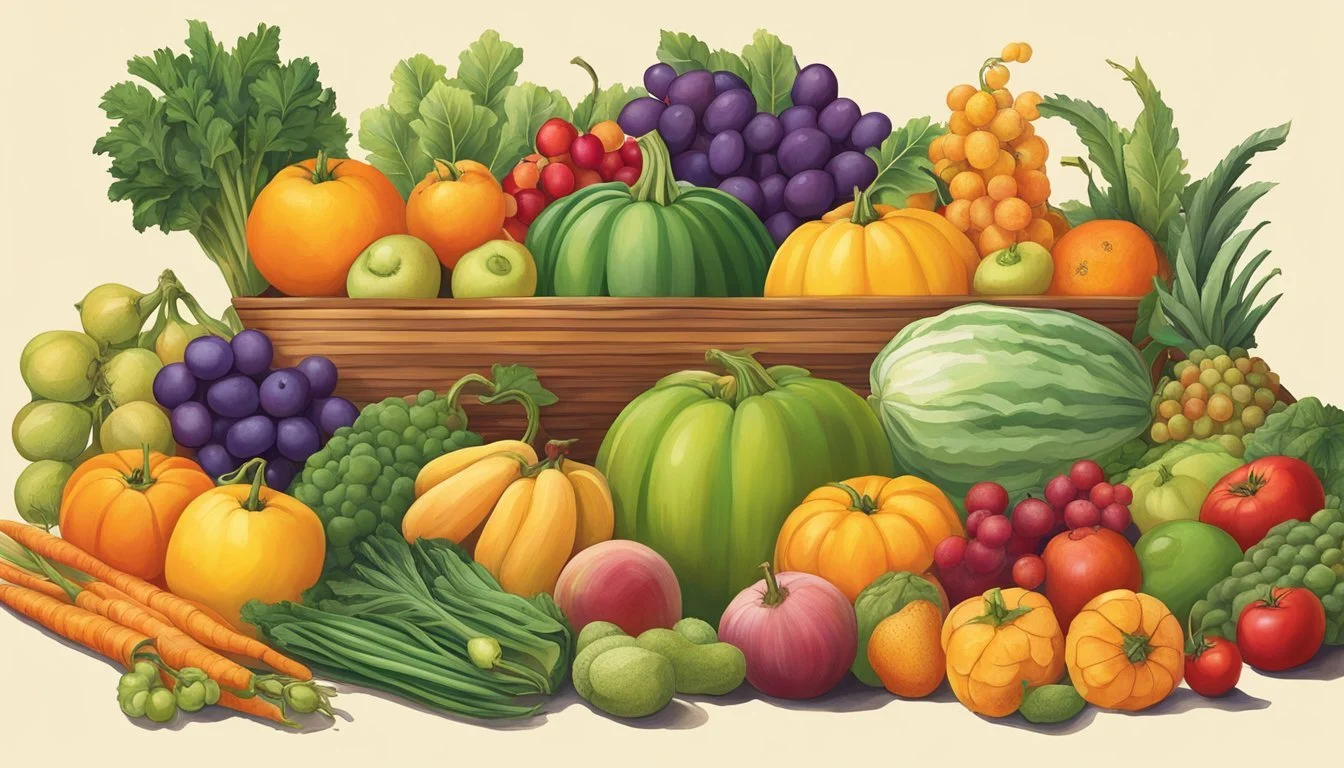California Seasonal Fruit & Vegetables in October
Your Autumn Harvest Guide
This Article is Part of our California Seasonal Fruit & Veg Calendar
California's diverse climate, ranging from Mediterranean to subarctic, is conducive to growing a wide variety of fresh produce. October marks a transitional period for farms throughout the state, where the last of summer's bounty begins to give way to the fall harvest. This unique seasonal overlap offers a unique array of fruits and vegetables to consumers.
Fruits such as blackberries become sweeter and less tart as they ripen on the vine, reaching their peak in flavor during October. This is also a prime time for other berries and stone fruits. Meanwhile, vegetable gardens and orchards yield a hearty harvest of greens, squashes, and root vegetables that thrive in the cooler temperatures of the fall season.
Shopping for produce in October in California means encountering a cornucopia of options. Farmers' markets and grocery stores are stocked with items that are best enjoyed during this time of year, ensuring that consumers have access to the freshest, most flavorful fruits and vegetables. Savvy shoppers look for ingredients that are at their peak, understanding that seasonal produce can provide the best in nutrition and taste.
Overview of California’s Seasonal Climate Influence
California's climate significantly shapes the availability and quality of its seasonal produce. In October, weather patterns begin to shift, affecting harvests and the quality of fruits and vegetables.
October Weather Patterns
In October, California begins transitioning from the dry heat of the summer to the milder temperatures of fall. The North Pacific High pressure system, which influences the state's dry summers, starts to weaken, allowing for cooler and occasionally wetter conditions. The retreat of this system also marks the beginning of the state's rainy season in some northern regions. On average, temperatures in October remain warm but start to drop by the end of the month, leading to a variety of climatic conditions that can impact different crops differently, often favoring late-season fruits and vegetables.
Impact on Harvests and Produce Quality
The diverse range of temperatures experienced in different parts of California during October can influence the timing and quality of harvests for seasonal produce. Warmer regions may continue to yield summer crops like tomatoes and peppers, while cooler areas begin focusing on autumn staples such as pumpkins and winter squash.
Temperature fluctuation: An increase or decrease in the daily maximum average temperature can affect fruit set, size, and quality. Mild October temperatures can support a longer growing season for some crops, allowing for a sustained yield of quality produce.
Precipitation patterns: The shift in weather patterns may lead to the first rains after a long dry period, which can refresh crops but also present challenges if intense or early rains affect harvest timing or produce quality.
Produce like stone fruits (peaches, plums) have already been harvested, while nuts like walnuts and certain citrus fruits are approaching their harvest season, potentially benefiting from the cooler October temperatures. It is important that farmers closely monitor weather forecasts to protect crops from unexpected weather events and optimize harvest times.
List of Seasonal Fruits
In October, California offers a bountiful selection of fresh fruits, with various types reaching their peak ripeness. Shoppers have the opportunity to enjoy everything from the last of the succulent berries to the beginning of the vibrant citrus season.
Citrus Fruits
October marks the early period for Citrus fruits in California. The citrus season begins with varieties such as:
These citrus fruits are known for their juicy segments and are often used in fresh salads, juices, and zesty desserts.
Late Season Berries
Although berry season is winding down, Late Season Berries like raspberries can still be found during this time. Shoppers may also find the last batches of:
Blackberries
Strawberries
Enjoy these berries fresh, in baked goods, or preserve them to extend the taste of summer a bit longer.
Exotic Fruits
Exotic Fruits such as pomegranates make their special appearance in October. This is the time when:
Pomegranates reach peak sweetness
Use their arils to add a pop of color and flavor to salads, drinks, and desserts.
Core Fruits
Core Fruits are at the heart of the fall produce spectrum. October heralds the harvest for apples and pears, with a variety of apples such as:
Fuji
Granny Smith
Gala
Pears like the crisp Bosc and buttery Bartlett are also readily available. These core fruits are perfect for baking or enjoying fresh.
List of Seasonal Vegetables
October in California is a bountiful time with an array of vegetables that are in their prime harvesting period. These vegetables offer diverse flavors and textures to enrich autumnal meals.
Root Vegetables
Beets: Known for their earthy sweetness, they can be roasted to enhance their flavor.
Radishes: Offering a peppery kick, radishes are perfect for a crisp addition to salads.
Turnips: Their slightly spicy taste softens when cooked and they can be mashed or used in hearty stews.
Leafy Greens
Spinach: This versatile green is tender and can be used fresh in salads or cooked in a variety of dishes.
Chard: With its slightly salty flavor, chard can be sautéed for a nutritious side dish.
Versatile Squashes
Squash: Ranging from butternut to spaghetti, squashes can be baked, pureed for soups, or stuffed.
Cruciferous Vegetables
Broccoli: It remains a staple in the kitchen, ideal for steaming, roasting, or adding to casseroles.
Cauliflower: Its adaptability allows it to be roasted whole, transformed into rice, or used in a multitude of recipes.
Health Benefits of Seasonal Produce
Engaging with the season's bounty, consumers benefit significantly from the nutritional advantages and freshness that October's produce in California has to offer.
Nutritional Value
In-season fruits and vegetables often contain higher nutritional value. For example, pumpkins, ubiquitous in October, are rich in vitamins A and C, which boost the immune system and reduce inflammation. Apples, also abundant, provide dietary fiber and vitamin C. Sweet potatoes are another nutritional powerhouse, offering vitamins A and C along with essential minerals like manganese.
Pumpkin: Vitamin A, Vitamin C, Fiber
Apple: Dietary Fiber, Vitamin C
Sweet Potato: Vitamin A, Vitamin C, Manganese
Advantages of Freshness
The freshness of produce that has not been stored for long means consumers receive it when it has retained most of its flavor and nutritional content. Freshly picked fruits like pears and cranberries in October are more likely to have retained their antioxidant properties compared to those that are stored for long periods. Furthermore, shorter transportation times for local produce also contributes to less nutrient degradation.
Pear: Antioxidants, Dietary Fiber
Cranberries: Vitamin C, Manganese, Antioxidants
Culinary Ideas for Seasonal Ingredients
October in California brings a blend of late summer and early autumn produce that can transform the kitchen with a variety of culinary creations. This is a time to explore hearty stews and roasted dishes, as well as fresh salads and savory sauces that feature October's seasonal fruits and vegetables.
Simple Recipes
One can utilize the sweetness of late-season stone fruits by incorporating them into a fresh fruit salad or baking them into a galette. Another idea is to showcase October's prime-time corn into grilled corn on the cob with a lime butter glaze. These simple recipes allow the natural flavors of the produce to shine.
Roasted Winter Squash:
Cut squash into chunks, drizzle with olive oil, season with salt, pepper, and a touch of cinnamon, and roast at 400°F until tender.
Blackberry Vinaigrette for Salads: -Puree blackberries with balsamic vinegar, olive oil, honey, and a pinch of salt to create a vibrant dressing.
Preservation Techniques
Preservation methods such as canning tomatoes can extend the taste of summer into colder months, while pickling offers a way to enjoy the crunch of fresh vegetables year-round. Freezing berries after a simple sugar syrup bath preserves their flavors for use in smoothies or desserts later on.
Canned Tomatoes:
Blanch tomatoes, peel, and pack into jars with herbs, and add a citric acid (how long does citric acid last?) before processing in a water bath canner.
Berry Freezing:
Toss berries gently with a sugar syrup and freeze on a tray before transferring to an airtight container.
Pairings and Combinations
The deep flavors of roasted vegetables like squash and tomatoes can be balanced with the acidity in berry sauces. Stone fruits grilled alongside meats offer a caramelized sweetness that complements the savory profile. Herbs like basil or thyme, which are also in season, can be matched to enhance these pairings further.
Tomato and Basil:
Use fresh tomatoes and basil in a classic Caprese salad (What wine goes well with caprese salad?), dressing with olive oil and balsamic reduction.
Roasted Squash and Thyme:
Pair roasted squash with thyme in a pureed soup or stew, adding a touch of cream for richness.
Shopping Tips for Seasonal Produce
When seeking out seasonal fruits and vegetables in California during October, consumers should focus on quality, locality, and cost-effectiveness. The benefits of in-season produce are freshest flavor profiles and nutrient densities.
Selecting the Best Quality
To ensure the best quality, shoppers should look for produce that’s heavy for its size, indicating juiciness and ripeness. For instance, a plump, heavy orange is likely to be juicier. Vegetables like broccoli should have a vibrant color and firm stalks. Seasonal fruits like blackberries should be shiny and plump without any shriveled sections, suggesting freshness and proper ripeness.
Finding Local Markets
Local farmers markets are treasure troves of in-season produce. They typically offer a variety of fruits and vegetables picked at the peak of their season. Shoppers can use resources like online market finders or community bulletin boards to locate nearby markets. Here, one can directly support local farmers and often find organic options.
Local Market Notable October Produce ABC Farmers Market Pumpkins, Apples, Pomegranates XYZ Organic Stand Sweet Potatoes, Brussels Sprouts, Figs
Budget Considerations
While grocery stores provide convenience, farmers markets can offer competitive pricing for in-season items due to reduced transport costs. Shoppers should compare prices and consider buying in bulk for canning or freezing to enjoy October produce like green peas and onions well into the winter months. Additionally, investing in seasonal produce can mean cost savings as these items are often priced lower due to their abundance.
Grocery Store: May have consistent pricing but look for sales on in-season items.
Farmers Market: Can negotiate prices, especially near closing times.
By embracing these shopping strategies for October's seasonal produce in California, individuals will enjoy the pinnacle of freshness and flavor while supporting the local economy and potentially saving money.
Understanding California’s Agriculture
California's diverse agriculture is sustained through a combination of varied farming regions and a strong emphasis on sustainability practices. These factors contribute significantly to the state's reputation as a powerhouse in agricultural production and innovation.
Farming Regions
In California, there are several distinct farming regions, each with its own climate and soil conditions conducive to different types of crops. The Central Valley is known for its fertile soil and is responsible for a significant portion of the nation's fruits, vegetables, and nuts. Coastal regions, such as those near Santa Barbara and San Diego, benefit from a milder climate, which is ideal for growing avocados and strawberries. The temperate wine regions of Napa and Sonoma are world-renowned for producing high-quality wines.
The diversity of these environments enables California to grow a wide range of produce year-round. In October, one can expect crops such as tomatoes, pumpkins, and various leafy greens to be in season. The geographical variation not only supports a broad spectrum of crops but also helps mitigate risks associated with climate and pest pressures.
Sustainability Practices
Sustainability is a key focus of California's agricultural practices. Local farmers and large-scale producers alike are increasingly adopting methods that conserve water, increase soil health, and reduce the environmental impact of farming operations. Water-saving irrigation technologies, such as drip irrigation and moisture sensors, help manage California's water resources more efficiently, an essential aspect given the state's history of droughts.
Sustainability practices in California also encompass the use of integrated pest management (IPM) strategies, reducing reliance on chemical pesticides. Crop rotation and the planting of cover crops also enhance soil fertility and prevent erosion. These practices showcase how California's agriculture is adapting to modern environmental challenges and consumer demands for more sustainable and local produce.
The Economic Impact of Seasonal Foods
In October, California's seasonal fruits and vegetables significantly influence its economy by boosting local markets and informing agricultural trends, which provides insights into sustainable economic growth strategies.
Local Economy Boost
The economic vitality of local communities in California is often uplifted by seasonal food production in October. Key crops such as pumpkins, apples, and various leafy greens come to harvest and are featured in farmers markets and local stores. The sale of these crops supports local businesses and fosters economic activity within the communities. For example, agritourism surrounding pumpkin patches and apple orchards plays a role in stimulating local economies through seasonal activities.
Agricultural Industry Trends
California's agricultural sector adapts to consumer demand and market trends, reflective in the seasonal shifts of fruit and vegetable production. Data from 2021 indicated that California generated approximately $51.3 billion in agricultural cash receipts, a substantial contribution to the state's GDP. As consumer preferences evolve and awareness of the benefits of consuming seasonal produce grows, the industry sees a trend toward diversification of crops and extension of growing seasons. This adaptability contributes to increased employment and a reduction in the seasonality of labor within the agriculture industry.










